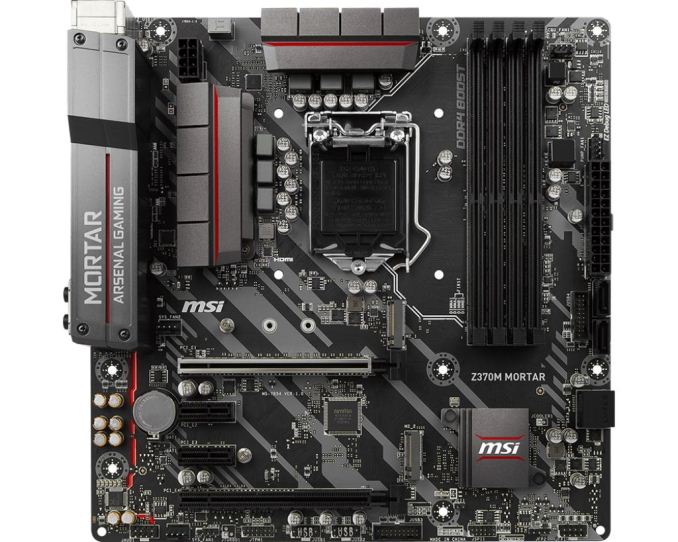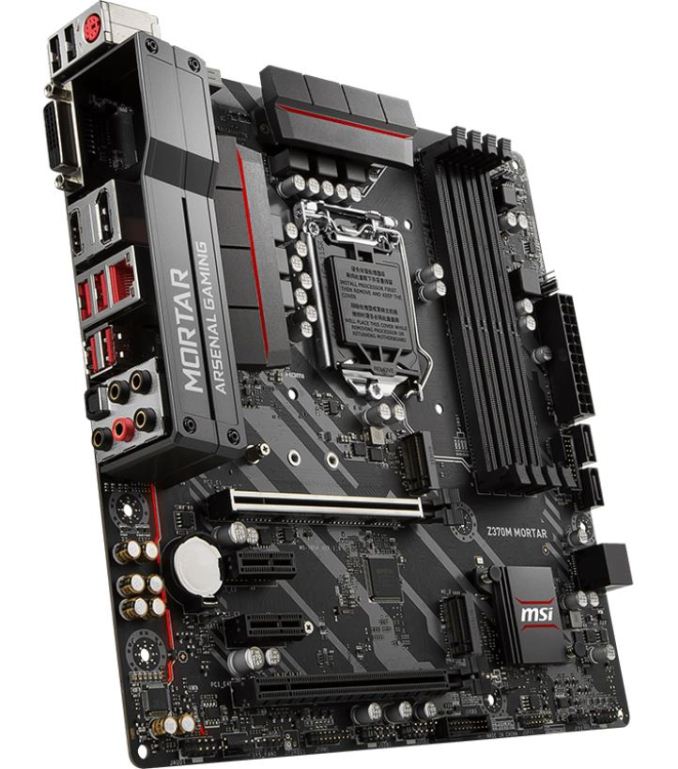Analyzing Z370 for Intel's 8th Generation Coffee Lake: A Quick Look at 50+ Motherboards
by Ian Cutress, Anton Shilov, Joe Shields & Gavin Bonshor on October 20, 2017 2:00 PM ESTMSI Z370M Mortar
The Mortar’s appearance does have a more rugged look compared to the other MSI micro-ATX board, the Z370M Gaming Pro AC. The Mortar’s back panel cover looks like it was taken from a military vehicle with the aesthetic only screws on both ends giving it an industrial feel. The heatsinks are simple grey with a red line through the middle, in contrast to the jet black PCB that has some grey design features on the board. There are no onboard RGB LEDs, with the only support provided through an onboard header. A single full-length PCIe slot is reinforced, with the focus for this board on single GPU setups. The PCH heatsink is a diminutive piece with the MSI name on it in white letters with red accents and is attached via pushpins.
MSI still uses all four memory slots here, capable of up to 64 GB and on-the-box speeds of DDR4-4000. Despite the industrial feel to the board, there is no memory slot reinforcement here, and MSI has used dual-sided latch mechanisms over the single-sided latch versions we sometimes see on high-end motherboards. For PCIe, the top reinforced slot handles the main add-in card duty, supporting PCIe 3.0 x16 direct from the processor. The other full-length slot is a PCIe x4 slot from the chipset, and the board also has two smaller PCIe x1 slots in between.
As with the other MSI micro-ATX board, there is only four SATA ports here, with two in a 'regular' position and the other two sitting vertically on the board just below the 24-pin ATX connector. These last two are also right next to a USB 3.0 internal header, and in a position that might make it difficult to release locking SATA cables if a front panel cable is attached to the USB 3.0 header. Other storage comes via dual M.2 slots, with the Mortar supporting 80mm drives in both, however, the first slot is PCIe only, with the second slot able to do both PCIe and SATA.
The Mortar will accept a total of four fans with its 4-pin headers, two of which are located around the chipset. The 4-pin headers support both PWM and voltage control. Network connectivity is through a sole Intel I219-V gigabit Ethernet controller, with the price of this board meaning that Wi-Fi is not present. The audio codec is also lower than 'normal' to save a few pennies, however the Realtek ALC892 codec still offers 7.1 channel support. MSI has at least offered some PCB separation to reduce electrical interference with the audio paths.
USB Support for the Mortar is missing the latest USB 3.1 (10 Gbps), but it has a total of eight USB 3.1 (5 Gbps) ports: there are four Type-A on the back panel, and four more available through the two internal headers. The board also has two USB 2.0 ports on the back panel and two internal headers. The rest of the Mortar’s panel consists of a combination PS/2 port, DVI-D/HDMI/DisplayPort video outputs, the network connection, and the audio jacks with SPDIF.
| MSI Z370M Mortar | |
| Warranty Period | 3 Years |
| Product Page | Link |
| Price | N/A |
| Size | Micro-ATX |
| CPU Interface | LGA1151 |
| Chipset | Intel Z370 Express |
| Memory Slots (DDR4) | Four DDR4 Supporting 64GB Dual Channel Support DDR4 4000+ |
| Network Connectivity | 1 x Intel I219-V |
| Onboard Audio | Realtek ALC892 |
| PCIe from CPU | 1 x PCIe 3.0 x16 slots |
| PCIe from Chipset | 1 x PCIe 3.0 x4 2 x PCIe 3.0 x1 slots |
| Onboard SATA | 4 x Supporting RAID 0/1/5/10 |
| Onboard SATA Express | None |
| Onboard M.2 | 2 x PCIe 3.0 x4 Slot 1 PCIe only Slot 2 PCIe or SATA |
| Onboard U.2 | None |
| USB 3.1 (10 Gbps) | N/A |
| USB 3.1 (5 Gbps) | 4 x Back Panel 2 x Headers |
| USB 2.0 | 2 x Back Panel 2 x Headers |
| Power Connectors | 1 x 24-pin EATX 1 x 8-pin ATX 12V |
| Fan Headers | 1 x 4-pin CPU 1 x 4-pin Waterpump 2 x 4-pin System Fan (All PWM or Voltage controlled) |
| IO Panel | 1 x Combination PS/2 2 x USB 2.0 1 x DisplayPort 1 x DVI-D port 1 x HDMI port 1 x LAN (RJ45) port 4 x USB 3.1 (5 Gbps) Type-A ports 5 x Audio Jacks + SPDIF |












83 Comments
View All Comments
tommythorn - Monday, October 23, 2017 - link
While that feature page is great, the thunderbolt part is slightly misleading as a few of them supports it via an add-in-card. The page only lists the one that has it built-in. (The lackluster support for TB3 as well as 10 GbE is disappointing).OFelix - Saturday, October 21, 2017 - link
ThanksStochastic - Friday, October 20, 2017 - link
Would you consider putting out some simple Wirecutter-style recommendations? A lot of people (including myself) would like someone else who is better informed to simplify the decision-making process.Ian Cutress - Friday, October 20, 2017 - link
When we get our Z370 reviews underway, we'll start doing some buyers guidesStochastic - Friday, October 20, 2017 - link
Great, thanks!IGTrading - Sunday, October 22, 2017 - link
When do we get a 50+ AMD motherboard article guys ? :)abrowne1993 - Friday, October 20, 2017 - link
Okay but which one looks the coolest?dave_the_nerd - Friday, October 20, 2017 - link
"Whoever thought this was a good idea at Intel needs to be fired."Well... gee... why don't you tell us how you really feel?
DigitalFreak - Friday, October 20, 2017 - link
This whole notch thing makes me wonder if the 8xxx series was originally supposed to work in existing motherboards, but Intel ran into issues at the last minute.KaarlisK - Saturday, October 21, 2017 - link
Honestly, I cannot see the issue. The pins were changed so that nothing bad will happen if you put the wrong CPU in the wrong motherboard.As for the notches, I for one am happy that they were not changed. This means they can reuse the physical design, which lowers validation costs, which makes the CPUs cheaper.